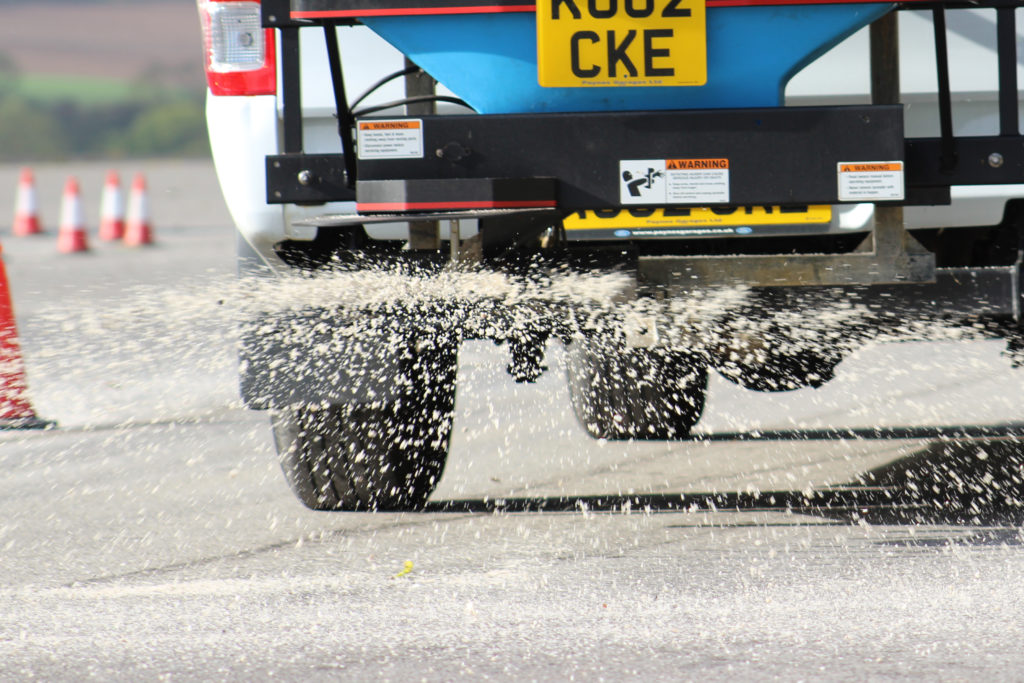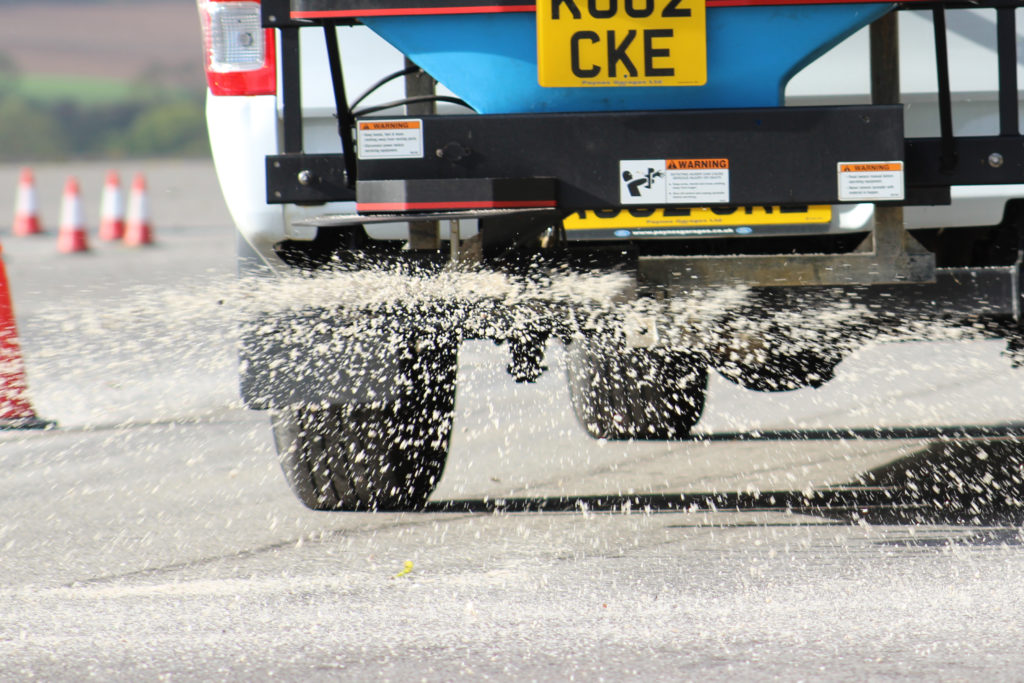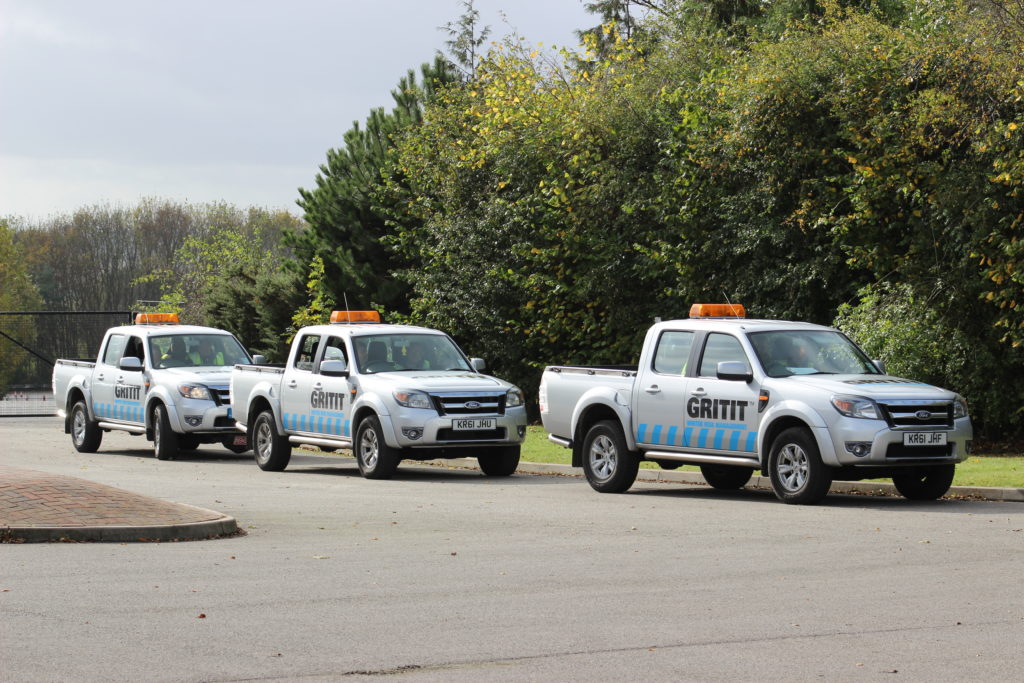Brendan Aherne, GRITIT’s regional director for Scotland, explains that taking on adverse weather conditions in increasingly litigious times takes careful planning and meticulous execution.
It’s just before 6am on Sunday when Steve arrives at the first of his sites, stopping at the gate and leaning out of the window of the gritting truck to tap in the code that’s recorded on the app on his smartphone. The security gate shudders open – a good sign, the code sent by the client was correct – and he pulls into the empty car park. It’s time to get to work. Alongside his vehicle he notices a thin stream of water running across the pavement, already spotting the danger posed by the forming ice. But on this still warm morning Steve doesn’t need to fetch a shovel and grit. Instead, he records the hazard of the leaking air conditioning unit as an advisory note to the client. It’s October and the cold weather is still weeks away.
This was Dry Run day – GRITIT’s full-scale nationwide enactment of how we handle the worst possible winter conditions. All across Scotland our gritting trucks and teams travel to shopping centres, hospitals, business parks and care homes, taking a full day to visit and assess the roads, car parks and paths of each of the sites that they will be gritting throughout the coming winter months.
Getting familiar with each location is time-consuming but vital work; when carried out for real, temperatures can fall to -8º or -9ºC, and there can be gales, rain, and of course snow. With work often conducted overnight, visibility will be limited and there’s no easy way to contact facilities management to get a correct door key or security code. Everything has to be planned ahead of time, and on Dry Run day, those plans have to be tested in full: With peak demand during winter involving thousands of jobs every night nationwide, even the night operation teams responsible for the systems that automatically track weather patterns and schedule gritting runs have to work through the day. Part of their role is to test the vehicle tracking and handheld systems that ensure both the safety of the teams working in risky environments and also compliance with activity logging requirements.
If this degree of readiness seems astonishing, consider that since September 80% of the grit supplies needed for the entirety of the coming winter were already in place – strategically placed around the country from Thurso to the Borders to ensure that adequate supplies are nearby regardless of the weather. And beyond our own process of getting ready at GRITIT, all across the country similar exercises will have been carried out – to varying degrees – by local authorities and the Highways Agency. A great example, of this can also be seen in the Scottish Government’s efforts to educate members of the public and business owners during its November ‘Resilience Week’. Today, this is what is means to be ready for winter.
GRITTING GOES PRO
Describing our own Dry Run day is always a good way to make people appreciate just how professionalised winter gritting has become over the past decade. This evolution can best be understood in terms of two key drivers: Changes in technology – a shift in the art of the possible – and changes in our awareness and exposure to risk.
While gritting itself seems low tech on the surface, virtually everything around the delivery of the service itself is being transformed by technology. Every industry today is becoming digitised and gritting is no exception. Arguably, it has actually been ahead of the curve in becoming a data driven service, as decisions as to when and how to grit sites has for some time been guided by increasingly accurate weather data. For example, the sector has adopted technology and location intelligence to automate service activation and scheduling whenever zero road surface temperatures are forecast and the precision of this automated decision making has only increased. The benefits of such an approach include ensuring a consistent and accurate response to unexpected bad weather, scheduling vehicle routes and service delivery for best results (i.e avoiding spreading grit at a site just before heavy precipitation), and preventing wasteful gritting on days when it isn’t needed. This last factor is particularly attractive to site managers as only gritting when needed delivers savings that add up considerably over the course of a winter.
Technological developments have also transformed the extent of service level guarantees that winter maintenance companies can provide. Mobile technology helps everyone in this respect: Operators like Steve have access to customer site plans and instructions on custom apps on their smartphones and this also cuts their admin by streamlining service delivery and the process of reporting. When Steve arrives at a site his vehicle logs his attendance and the time of the visit and he scans a QR code at the site on his mobile to confirm when the work has been completed. All of this data is available to customers via post service notifications and online in real time so they know exactly when a site has been gritted. Crucially, this same information is available after the fact and this is important when addressing the second factor that is driving the evolution of winter maintenance – risk management.
UNDERSTANDING YOUR RESPONSIBILITIES
Think again about the gritting contractors nationwide and their intensive preparations. You might wonder if this degree of readiness is needed by the majority of organisations. Consider the legal context: The Health and Safety at Work Act 1974 states that employers have a Duty of Care to ensure, so far as is reasonably practicable, the health, safety and welfare at work of all employees, including the provision of a safe working environment. This Duty of Care also extends beyond staff to anyone visiting, or passing by the facility, including suppliers on company business and members of the public. As a result every organisation must be able to demonstrate that they have done everything reasonable to meet these obligations to make sites safe for staff and customers.
Failure to adequately plan and act can obviously impact on anyone unlucky enough to suffer a fall but it can also harm an organisation’s reputation and bottom-line. Legal actions can have severe financial impacts and recent years have seen society become increasingly litigious with the rise of the ‘no win, no fee’ culture. Most worryingly, ‘slipping on ice’ accidents have the potential for the most high value claims and compensation. As a result, proactive winter maintenance planning is becoming even more vital as a way to help businesses to mitigate risks. Technology has changed what can be done, while increasing risk is driving what should be done.
A WINTER MAINTENANCE PLAN
One of the consequences of the increasing professionalisation of gritting in response to growing risk awareness is that it has, in turn, redrawn our understanding of what constitutes taking reasonable measures. However, there’s no reason to be discouraged from taking this challenge on and there are practical steps that organisations can take. Whether handling gritting in house or through a contractor, best practice starts with planning how your organisation will take action in the event of adverse weather. A robust winter maintenance plan that is embedded into your organisation’s health and safety policies can help you meet your Duty of Care and meet the expectation of insurers, while reducing risks and helping ensure business continuity.
Let’s look at what any effective plan should include:
- Use of a recognised health and safety management system such as OHSAS1800115 to ensure the plan is fit for purpose.
- Clearly defined and communicated responsibilities – both on the ground and with a senior ‘champion’ to ensure high level management buy-in.
- A process for documenting the proactive actions, incidents and investigations undertaken with records maintained and kept for a minimum of three years.
- Ensuring the plan is based on detailed surveys to identify hazard areas and that action is undertaken according to real time accurate weather data and agreed action triggers for service.
- Adequate resourcing with a dedicated and trained team who have sufficient and well-maintained Personal Protective Equipment (PPE).
- Clearly defined KPIs to measure performance against and a process to review the plan and any KPIs on a regular basis (at least bi-annually)
- For detailed guidance on planning, you can download a free best practice guide from the BIFM and GRITIT at http://www.gritit.com/services/winter-risk-management.
The UK often seems to be lagging behind other countries in managing extreme weather, and part of the reason is that readiness does take an investment of time and resource. However, looking only at the short-term cost implications of having a winter maintenance plan in place is to neglect the bigger risks of being found wanting in the event of an accident. And even if you don’t approach winter like a military operation, it’s smart to get serious about gritting.
GRITIT provides winter gritting, grounds maintenance & landscape management services. www.gritit.com






